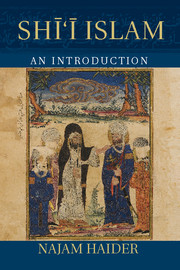Book contents
- Frontmatter
- Dedication
- Contents
- List of Tables and Maps
- Acknowledgments
- Note on the Cover Image
- A Note on Transliteration and Dating
- Maps
- Introduction
- Section 1 Theology
- Section 2 Origins
- 3 Community
- 4 Fragmentation
- Section 3 Constructing Shī‘ism
- Section 4 Shī‘ism in the Modern World
- Appendix Verses Mentioned in the Argument from Qur’ānic Expectations in Chapter 3
- Index
- References
3 - Community
Published online by Cambridge University Press: 05 August 2014
- Frontmatter
- Dedication
- Contents
- List of Tables and Maps
- Acknowledgments
- Note on the Cover Image
- A Note on Transliteration and Dating
- Maps
- Introduction
- Section 1 Theology
- Section 2 Origins
- 3 Community
- 4 Fragmentation
- Section 3 Constructing Shī‘ism
- Section 4 Shī‘ism in the Modern World
- Appendix Verses Mentioned in the Argument from Qur’ānic Expectations in Chapter 3
- Index
- References
Summary
Two historical narratives are shared by all Shī‘ī groups. The first focuses on the succession to the Prophet and, specifically, the community's elevation of Abū Bakr to the caliphate over the superior claims of ‘Alī. The second centers on the death of Ḥusayn (the Prophet's grandson) and a small contingent of his family and followers at the hands of an Umayyad army in 680. The discussion that follows explores the importance of each of these narratives in the construction of a distinct Shī‘ī identity.
The Succession to Muḥammad
According to the Shī‘a, the Muslim community's rejection of ‘Alī marked a fundamental departure from Muḥammad's desires and represented a loss of legitimate political and religious leadership. As mentioned previously, this event is often cited as the starting point for the Sunnī-Shī‘a division. In reality, however, its significance emerged gradually through its incorporation into a growing corpus of polemical arguments. The most important of these arguments combined (i) events and statements from the Prophet's life with (ii) general expectations for succession embedded in the Qur’ān. The Twelvers and Ismā‘īlīs were particularly interested in historical episodes that suggested that the Prophet had explicitly appointed ‘Alī as his successor. This was a product of their requirement that an Imām be formally designated (naṣṣ) by his predecessor (see Chapter 2). The Zaydīs were bound by no such requirement and offered a more subtle case for ‘Alī's claims grounded primarily in Qur’ānic expectations. Each of these arguments is discussed in this section.
- Type
- Chapter
- Information
- Shi'i IslamAn Introduction, pp. 53 - 83Publisher: Cambridge University PressPrint publication year: 2014

